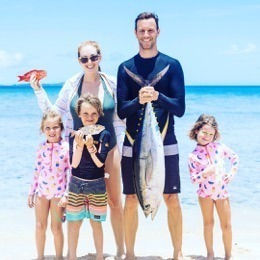Dr Colleen Lau
Food and Water-borne Diseases
The same precautions with food and water for developing countries apply in the Pacific Islands: Cook it, peel it, boil it, or forget it! However, it is not always easy to follow these rules at all times during travel. Depending on your trip, your travel doctor might recommend vaccinations for Hepatitis A, typhoid, and travellers’ diarrhoea. It is always a good idea to have a simple medical kit with medications for treating traveller’s diarrhoea, and correct treatment could mean that you are better in a few hours rather than being sick for days or even weeks.
|
Kayaking in Pago Pago Harbour, American Samoa – Chosen by Lonely Planet as one of the top 15 experiences in the Pacific Islands! |
Blood-borne and Sexually Transmitted Infections
Hepatitis B is common in the Pacific Islands, and an estimated 25 to 30% of the local population have chronic Hepatitis B infection. Travellers should consider Hepatitis B vaccination if they plan to live or work in the Pacific, or expect to have close contact with the local population. All Australian children are now routinely vaccinated for Hepatitis B. Sexually transmitted infections are common, and HIV is also becoming a problem.
Others
There is no risk of rabies on the Pacific Islands, but dog bites are common on some islands, and American Samoa has the unenviable reputation of having the highest incidence of dog bites in the world! Scuba diving is a popular activity, but there are few decompression chambers in the Pacific in case of mishaps. The Divers Alert Network provides information and insurance for scuba divers. Ciguatera fish poisoning is caused by marine microalgae in the tropics, and can cause nausea, vomiting, abdominal pain, diarrhoea, muscle cramps, paraesthesia, and a reversal of hot and cold sensation. It is riskier to eat large fish because they accumulate for toxin by eating smaller fish. As a general rule, if the fish fits onto a dinner plate, Ciguatera is unlikely to be a problem. It is best to avoid eating large reef fish such as barracuda and grouper. More information on ciguatera can be found in the June 2009 edition of the TMA Newsletter.
Natural hazards such as cyclones, earthquakes, and volcanic eruptions are part of everyday life, but serious disasters are relatively rare. Indeed, volcanic activity is responsible for creating many stunning and incredible landscapes throughout the Pacific, including extinct craters filled with rainforests and bats, tiny islands with sharp jagged peaks piercing the sky, abandoned villages half buried by old lava, and active volcanoes that are still erupting today.
Tinakula, Temotu Province, Solomon Islands. On a rest day from fieldwork, the local team on the Solomon Islands showed me their active volcano, which was about an hour’s boat ride from where we were working. Tinakula is only 3.5km wide, but rises 850m above the ocean, and has been uninhabited for decades because of eruptions. Even from a far distance, it is clear that Tinakula is highly active, with smoke pouring out from the top of its cone. But the true forces of nature could only be appreciated from up close, where rumblings from the volcano could also be heard and felt, and hot rocks seen spurting into the sky, and then tumbling down the hill into the ocean with a big steaming splash.
… Prepared by Dr Colleen Lau, TMA Perth and Brisbane
Read More »



